
Vespertilionidae is a family of microbats, of the order Chiroptera, flying, insect-eating mammals variously described as the common, vesper, or simple nosed bats. The vespertilionid family is the most diverse and widely distributed of bat families, specialised in many forms to occupy a range of habitats and ecological circumstances, and it is frequently observed or the subject of research. The facial features of the species are often simple, as they mainly rely on vocally emitted echolocation. The tails of the species are enclosed by the lower flight membranes between the legs. Over 300 species are distributed all over the world, on every continent except Antarctica. It owes its name to the genus Vespertilio, which takes its name from a word for bat, vespertilio, derived from the Latin term vesper meaning 'evening'; they are termed "evening bats" and were once referred to as "evening birds".
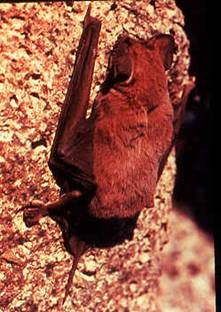
The Molossidae, or free-tailed bats, are a family of bats within the order Chiroptera. The Molossidae is the fourth-largest family of bats, containing about 110 species as of 2012. They are generally quite robust, and consist of many strong-flying forms with relatively long and narrow wings with wrinkled lips shared through their genus. Their strong flying form allows them to fly 60 miles per hour using tail winds and at altitudes over 10,000 feet. This makes them unique among bats, as they are the only bat family that withstands the elevation. They are widespread, being found on every continent except Antarctica. They are typically found in caves, abandoned mines, or tunnels.

Micronomus norfolkensis is a species of molossid bat, a family of flying mammals. The bat is endemic to Australia, where it occurs from southeastern Queensland to eastern New South Wales. They are the sole species of genus Micronomus and referred to by variations on east-coast free-tailed bat.

Beccari's free-tailed bat is a species of bat in the free-tailed bat family Molossidae found to Indonesia and Papua New Guinea. It can be found in several habitat types, including savanna, tropical moist forest, and fragmented and urban habitat. It roosts in trees, caves, and buildings in small colonies. This is a common species which is not considered to be threatened. The names Beccari's free-tailed bat or Beccari's mastiff bat once applied to populations in Australia.

Ozimops planiceps is a small bat in the family Molossidae, native to Australia and Indonesia.

Peters's wrinkle-lipped bat, also called Peters's goblin bat, is a species of bat in the family Molossidae, the free-tailed bats. It is endemic to Madagascar, where it is widespread and in some areas abundant. It commonly roosts in human-made structures, sometimes in colonies with other free-tailed bat species. It forages in the open, often in agricultural areas. The bat is sexually dimorphic, with males larger than females.

Kalinowski's mastiff bat is a species of bat in the family Molossidae, the free-tailed bats. It is native to Peru and northern Chile. Relatively little is known about the species, but it is thought to be common in its range. It is sometimes seen in urban areas. Molecular sequencing data indicates that the closest relatives of M. kalinowski are members of another genus, Nyctinomops.
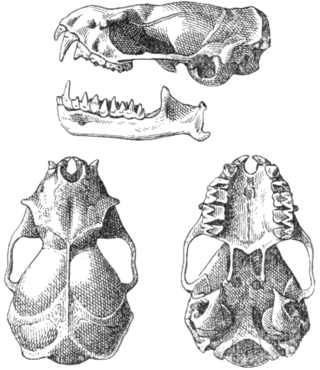
The little goblin bat is a species of bat in the family Molossidae, the free-tailed bats. It is endemic to Cuba.
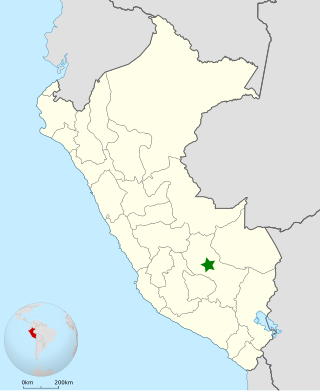
The Incan little mastiff bat is a species of bat in the family Molossidae, the free-tailed bats. It belongs to the subgenus Micronomus.
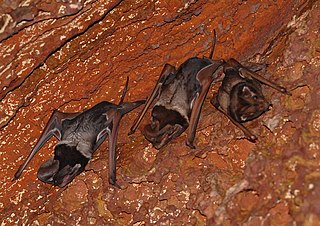
Otomops is a genus of bat in the family Molossidae. Molecular sequence data supports it as a monophyletic taxon, although not a number of other molossid genera.

Mops is a genus of bats in the family Molossidae. Molecular sequence data indicates that Mops and Chaerephon are not monophyletic taxa. However, the grouping of Chaerephon and Mops was found to be monophyletic when excluding C. jobimena.
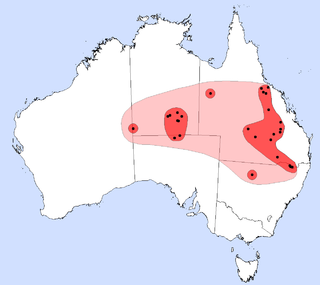
Setirostris eleryi is a species of small insectivorous bat found in inland eastern Australia. It is the sole species of the molossid genus Setirostris, a name that refers to the coarse bristles on their faces. Earlier common names have referred to this unique feature, and the 'free-tail' that is a common feature of its microchiropteran family, the Molossidae; no single common name emerged during the taxonomic revisions that identified what was referred to as the bristle-faced freetail.
Ozimops loriae is a species of bat found in Australia and Papua New Guinea.
Ozimops ridei is a species of molossid bat found in eastern Australia.
Ozimops petersi, the inland free-tailed bat is a species of bat found in Australia.
Ozimops kitcheneri, the south-western free-tailed bat, is a species of molossid bat found in Southwest Australia. A small flying mammal, it forages in forests and woodlands for insects.
Ozimops is a genus of molossid bats found in Australia, Indonesia and Papua New Guinea.
Ozimops lumsdenae is a species of molossid bat found in Australia, the largest of the genus Ozimops.
Ozimops cobourgianus is a species of molossid bat, insectivorous flying mammals known as freetail bats, which are found in north and west coastal regions of Australia. First described in 1959, the group were later recognised as species Mormopterus cobourgianus and soon placed with a new genus. They are associated with mangrove habitat and roost in the hollows of those trees, and known to seek food there and in eucalypt or melaleuca woodland or other coastal habitat. A smaller bat of genus Ozimops, O. cobourgianus are around fifty millimetres long and weigh six to ten grams. Little is known of their habits.
Ozimops halli, also referred to as the Cape York free-tailed bat, is a species of molossid bat found at the Cape York Peninsula in Australia.












